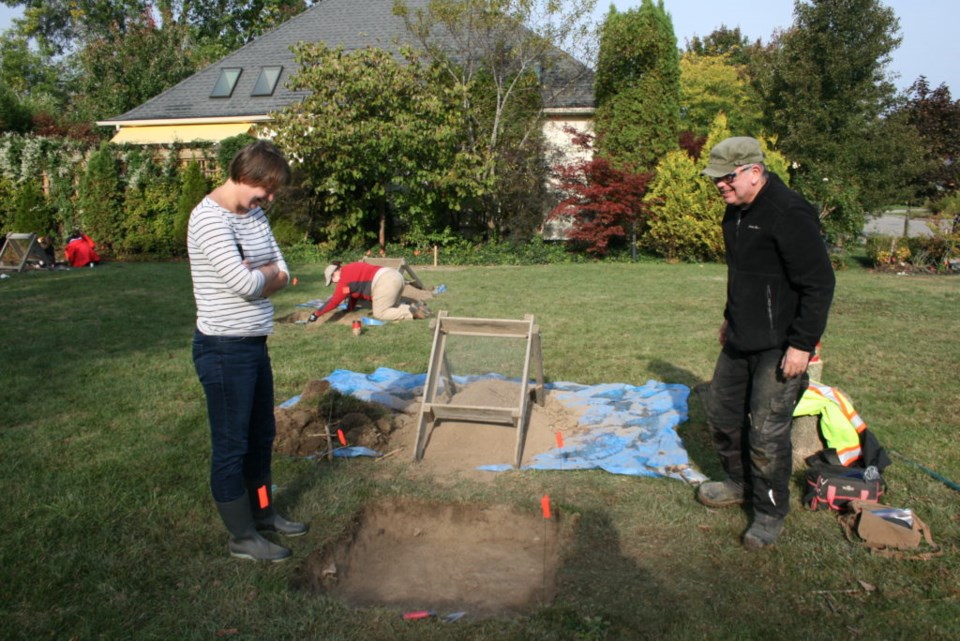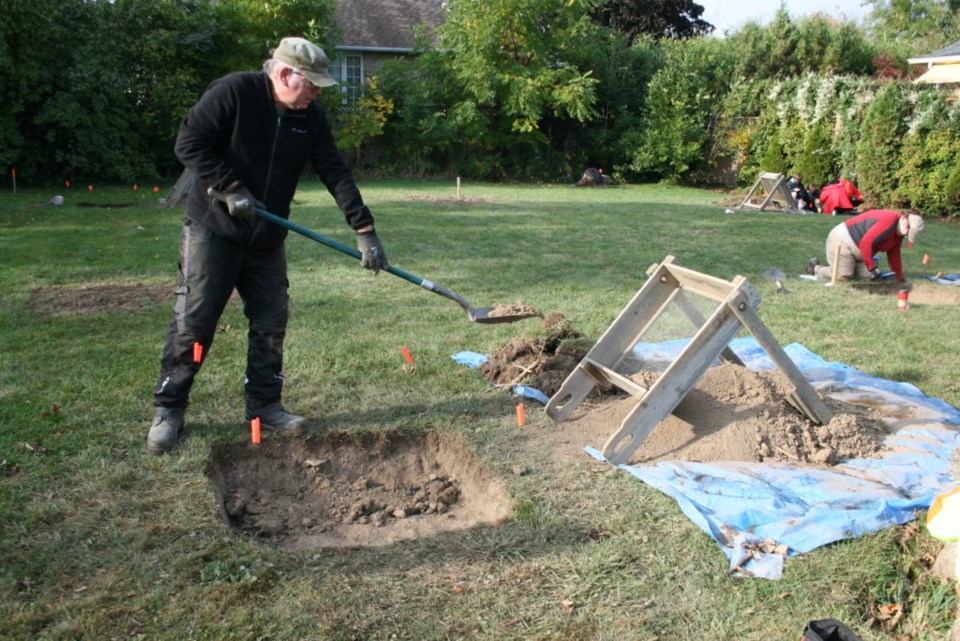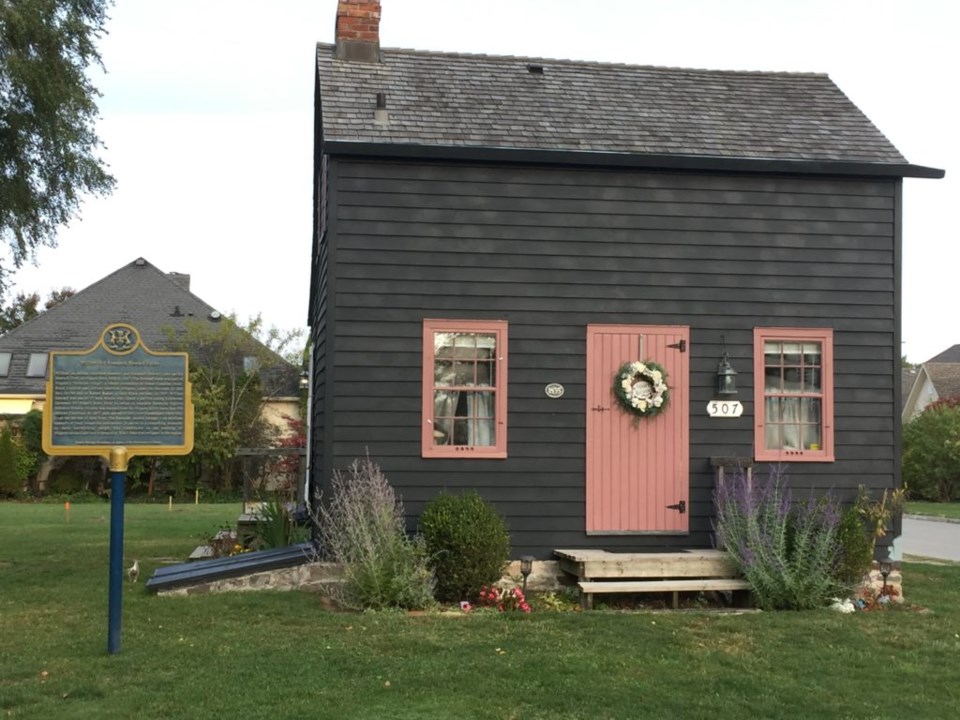
Little pieces of Niagara-on-the-Lake history were being unearthed this weekend at the corner of John and Butler Streets, though it may take a few weeks to determine whether anything of significance was discovered.
A crew from North Bay-based Horizon Archaeology was at the site of the William and Susannah Steward House to conduct a stage 3 archaeological assessment of the heritage home. The house, which was restored by the Niagara Foundation before being sold to a private owner, is a significant piece of the region’s Black history.
Victoria Brooks-Elder, head archaeologist at Horizon, was leading the dig, which began Friday afternoon. According to Brooks-Elder, another company completed the stage 1 and 2 portions of the assessment in 2013. That consisted of historical background research and a test-pit survey. Some of the items found seven years ago warranted this weekend’s stage 3 survey, known as the initial test.
“It’s been a fairly mixed bag,” says Brooks-Elder, about what they found over the three days. “Not a lot of ceramic, quite a bit of animal bone, some of which had been burnt, your chickens and cows you’ve been eating, quite a bit of brick, a lot of nails. A lot of milk tags and bread tags. Nothing all that crazy.”
The lot behind the Steward House measures about 40-by-40 yards. Brooks-Elder said that according to 19th century mapping, there was never a house on that part of the site. “My next step,” she tells The Local, “is to contact the museum, and hopefully they have some fire insurance maps of the area that will show me if there were any structures there.”
Brooks-Elder, her colleagues and a few volunteers had mapped out a 10-metre grid, and were busy digging, scraping and screening for artifacts at four different 1-by-1 metre locations within the grid. As items revealed themselves on the sifting screens in the shaker boxes, they were quickly assessed and bagged for further investigation.
It looked like back-breaking work, and Brooks-Elder confirms that assessment. “Archeology is probably the most blue-collar white-collar job you can get, though I’m sure geologists would disagree with me. A lot of us have hip and knee replacements.”
It’s clear the current owner of the house has some plans to build something on the lot, though nothing could be confirmed at press time. “I never get told what’s going on in terms of the development, or why the property needs it,” says Brooks-Elder. “I just get told to get out there and do it. I’m guessing it’s probably a condition of whatever he wants to do to it. As an archaeologist, I care about what’s in the dirt, not what you’re going to do to it.”
“Niagara has an amazing heritage program,” she continues. “They probably red-flagged this because of the historical value attached to the Steward home.”
The historical plaque at the site explains that William Steward was an African American teamster. He and his wife Susannah Steward lived in Niagara from 1834 to 1847. The Steward home was part of what was known then as the “coloured village,” a community of former Canadian slaves, black Loyalists and African American refugees. In 1837, William Steward was one of 17 local Blacks who signed a petition asking Lieutenant Governor Sir Francis Bond Head to refuse to extradite Kentucky fugitive Solomon Moseby, who was rescued from the Niagara jail by more than 200 African Canadians. The Stewards eventually moved to Galt, now known as Cambridge.
The house at 507 Butler Street is an excellent example of local vernacular architecture. It serves as a memorial to these hardworking people who contributed to the building of Niagara-on-the-Lake and to protecting African American refugees in the region.
Elizabeth Pilzecker currently rents the one-bedroom, two-bathroom open concept house. She was thrilled with the activity in her backyard this weekend. “It’s awesome, I love it,” says Pilzecker. She says she chose to live in the house because of its historical value. During the dig on Sunday, she could be seen looking over the shoulders of the archaeologists and asking questions about their findings as they were excavating the site.

Following the weekend activity, the artifacts will be trucked back to Horizon’s offices in North Bay, where they will be cleaned and analyzed by Brooks-Elder and her staff. “We have a cataloging system we use that will help us date the layers. If we have certain ceramics, that helps us date the findings. In terms of what we call Euro-Canadian history, you can even get into socio-economics.”
The analysis and assessment of the discoveries will take at least two weeks. According to Horizon’s website, if artifact counts and archaeological features found during this stage are sufficiently significant based on Ministry of Tourism and Culture guidelines, the site will be recommended for either avoidance or a stage 4 assessment, which entails a full excavation. If nothing substantial or significant is discovered, the process stops and the property owner can proceed with development plans.
As for the fate of the artifacts, they won’t necessarily make their way back to Niagara any time soon. “They get stored together as a collection,” explains Brooks-Elder. “Part of my contract with the ministry is that I have to take care of the artifacts forevermore, and I have them in keeping for the people of Ontario. If another archaeologist wanted to study the site, they could ask me for the artifacts and they’d be available.”

Although once considered as a possible museum, it was instead sold to a private owner.